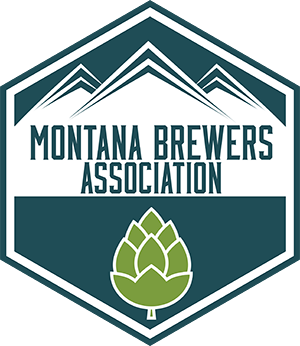

The MBA has cancelled all three Montana Brewers Rendezvous for 2020 due to the COVID-19 pandemic. Rather than cancel the Montana Brewers Conference we are going virtual with the annual event. Originally planned for October 1-2 in Missoula, the conference will now take place online over five days – Monday, September 28, to Friday, October 2, with a series of webinars and panel discussions via video conference.
Registration is now open for the virtual conference with a registration fee of $15 for MBA members and $25 for non-members (registration for speakers and sponsors is free). Those registered for the conference will receive updates and reminders about the conference schedule as well as links for each of the conference sessions.
We are pleased to announce the keynote speaker will be Neal Stewart, VP of Sales & Marketing at Deschutes Brewery. Prior to joining Deschutes Brewery in 2019, Neal was VP of Marketing at Dogfish Head for five years. He started his career in the beer industry with a rebranding process for Pabst Blue Ribbon that resulted in three consecutive years of growth for the first time in more than 20 years. We are very excited to have him join us in October!
Our full agenda and schedule is still forming, but we have speakers lined up for such topics as packaging challenges with hazy IPAs, safety and risk management, economic trends in the industry, and the growth of craft malting in Montana. BA Economist Bart Watson will be joining us to share his economic research, John Olaechea from OSHA will be there to talk about the agency’s Regional Emphasis Program, and Ray Daniels, founder of the Cicerone Certification Program, will lead a discussion on how to talk about beer.
This year our theme is “It’s Better Up Here” speaking to the quality of life we enjoy under the Big Sky. In Montana, it is easy to see how our lives are filled with quality experiences and our breweries are certainly producing the highest quality products with local, quality ingredients. We will take a deep dive into how quality affects every aspect of Montana’s brewing industry.
A big shoutout to our conference sponsors for sticking with us through this challenging and tumultuous year. We wouldn’t be able to pull this together without their support. Thank you to our sponsors!
Tour Level
Gold Level
Silver Level
Bronze Level
Like our 2019 conference, we will host sessions that focus on Technical, Front of House, Business, and General aspects of the brewing industry. We understand that 2020 severely disrupted all breweries in Montana (and the United States). We want to use the conference as an opportunity to regroup and share what we’ve learned facing these challenges.
Cancelling all three of our brewfests is an unfortunate but necessary move in light of the public health risks associated with large gatherings. The Spring Rendezvous in Bozeman was scheduled for May 8, the Summer Rendezvous in Helena was scheduled for August 1, and the Fall Rendezvous in Missoula was scheduled for October 3. We’re hopeful that we’ll be able to get together with craft beer lovers once again in 2021 and look forward to raising a glass with you again. It will be quite the celebration when we do.
Please check out the conference website if you’d like to learn more about the conference or to register.
Last week, the MBA launched a fun, interactive social media campaign called “Take Your Beer Outside.” Breweries and craft beer enthusiasts across the state are joining in, sharing images of outdoor adventures with Montana craft beer.
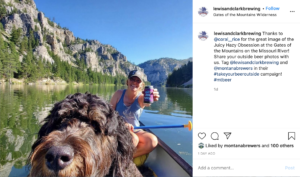
“With our three annual brewfests canceled this year due to the pandemic, we were looking for a way to engage Montana craft beer lovers and draw the connection between exploring Montana’s great outdoors and enjoying the great beer coming from Montana breweries,” said MBA Executive Director Matt Leow.
Participation is free and easy – simply take a photo of your favorite Montana craft beer while enjoying one of Montana’s many outdoor activities, post it to your social media pages, use the hashtags #takeyourbeeroutside, #MTbeer and tag the brewery and @MontanaBrewers. The person with the most likes on each platform (Facebook and Instagram) will receive two MBA hats and two MBA lanyard koozies.
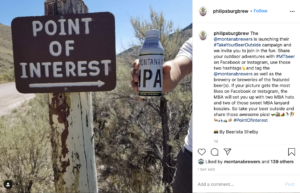
Whether it’s enjoying a cold one after a mountain bike ride, floating a river with a variety of Montana beers in the cooler, or sharing beers with friends around the campfire, Montana craft beer and outdoor recreation are a natural pairing. Just one week in, there are already some great photos being shared. Check out a few of the most popular so far:
Go to the Montana Brewers Association’s Facebook and Instagram accounts to see the latest and get inspired to post some shots of your own!
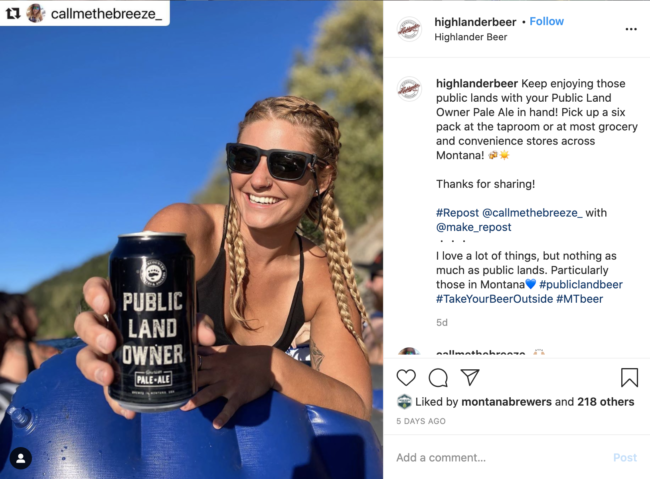
Now is the time to get your MBA Raffle Tickets! Tickets are $25 EACH or FIVE FOR $100 and can be purchased at most MBA breweries.
Tickets can also be purchased via mail by sending a check to: Montana Brewers Association, P.O. Box 763 Helena, MT 59624. Just be sure to mail your check no later than September 25th (one week prior to drawing). Drawing will be on October 3, 2020 by a random drawing of all entries from all tickets sold. Reach out via social or email for any questions: [email protected]
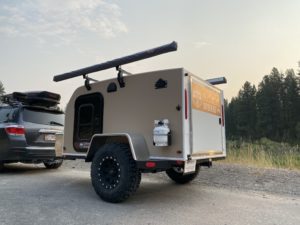
Winner receives the ultimate custom adventure trailer – The Offroad from Sherpa, made right here in Montana. The camper features dual awnings, stereo, a mounted propane tank, solar power system, tailgate table, side table, pressurized water tank, and more great features. $13,000 VALUE
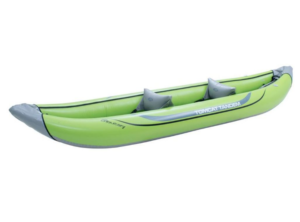
Winner receives a Tributary tandem inflatable kayak from AIRE. Paddle and pump included. $1,100 VALUE
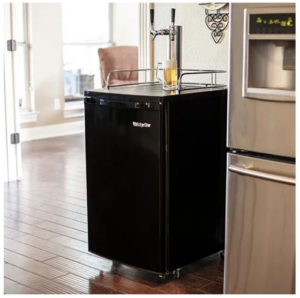
Winner receives an Edgestar kegerator with two custom tap handles, plus we’ll cover the first two kegs of beer. $930.00 VALUE
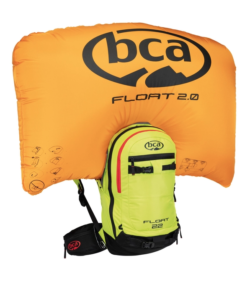
Winner receives Backcountry Access Float 22 Airbag Pack for off-piste and backcountry skiing and snowboarding. $570 VALUE
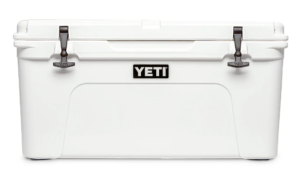
Winner receives a YETI Tundra cooler filled with an assortment of Montana craft beer. $550 VALUE
RULES: This is a charitable raffle for the Montana Brewers Association. Must be 21 to enter and be eligible for the listed prizes. The sale of raffle tickets is restricted to events and participants within Montana, unless the purchase is not prohibited in the jurisdiction in which the purchaser resides. Tickets sales may not be conducted over the internet. The raffle drawing will be conducted on October 3, 2020 by a random drawing of all entries from all tickets sold. Need not be present to win. The winners will be notified by phone or email, and are responsible for picking up their prizes.
You may have noticed over the last year or so, macro-producers of flavored malt beverages (FMBs) have penetrated the alcohol market in a big way. Hard seltzers are growing like crazy in off-premise sales, and recent data shows this segment could possibly become bigger than craft in the future.
Consistently reliable through off-premise sales, FMBs are becoming increasingly common in bars and restaurants and even outpacing stalwart beer styles in those spaces. According to IRI data, the top 10 brands have each surpassed $100 million in sales in the 52 weeks prior to March 2020. At this point, the runaway growth of FMB’s seems unstoppable. So why are hard seltzers becoming so popular?
The rise in popularity of hard seltzer has been fueled by the recent trend toward more health-conscious drinking habits and a preference for low-alcohol beverages, particularly among millennials. These carbonated water–based seltzers, which are made either from malted barley or fermented sugar, typically clock in at 100 calories or less per serving, compared with heavier beers, wines, or cocktails that have from 100 to 400 calories per serving. They’re also gluten free, which provides an alcoholic alternative for those looking to minimize gluten intake.
How big will the segment become in a couple of years? Well, IRI estimates that “if seltzer grew at 350% year-over-year for two more years it would be the majority of beer dollar sales.” There are some signs that seltzer growth is slowing, but slowing only relative to overall growth. Data from IRI suggests this market is still expanding nation-wide. Seltzer is now a huge category that may not have caught up with craft’s sales just yet, but is on its way.
Compare these trends to craft beer. Most of the growth in the craft beer market over the last 10 years is attributed to the on-premise segment, be it through the brewer’s own taproom or neighborhood establishments. But as brewers have become painfully aware in the age of COVID, reliance upon on-premise sales is a volatile strategy.
On top of all this, alcohol demands are shifting with an aging population of craft beer drinkers cutting back and a younger more health-conscious generation generally consuming less alcohol. Fear not, responding to changing habits of drinkers seeking innovative alternatives is a pathway the craft beer industry has deep experience successfully navigating!
IRI had an interesting take away relevant to craft producers; Increasingly, craft beer drinkers are also seltzer drinkers. “The percentage of craft drinkers who say they also drink seltzer is rising.” says Bart Watson, chief economist from the Brewers Association. He pointed to their annual craft consumer survey, done in conjunction with Nielsen, to show that “the percentage of craft drinkers saying they drink seltzer at least once a month has steadily increased, from 28% in 2018 to 36% in 2019 and finally 52% in 2020.” Good news for craft breweries already making, or considering adding a hard seltzer to their line up.
“Our goal as craft brewers looking to gain market share in this segment should be to supplant the category with unique offerings in stark contrast to the myriad “run of the mill” iterations that have convoluted what we used to know as the beer aisle,” says John Griffith, CEO of the Bozeman-based Zesty. 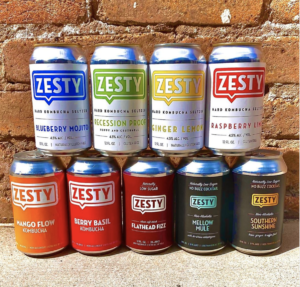
They’re getting creative at Zesty when they think about seltzer recipes; using local and regional hop varieties instead of fruit in their Recession Proof hoppy hard seltzer. Griffith says to “think functionality, real food ingredients, unique processes, healthy appeals, and exciting flavors that cater to those with more adventurous palates.”
Several Montana craft breweries entering the fray have done just this by creating innovative processes, using local and regional ingredient varieties and testing new flavor combinations. Zesty is combining the functional benefits of oak-aged kombucha to round out the profile of their hard seltzers, which is helping consumers reduce their sugar intake while still providing a flavorful experience. Helena’s Lewis & Clark Brewing Co. is also utilizing fresh ingredients to stand apart from the crowd. This year they unveiled their hard seltzer crafted with alcohol from refined Montana sugar beets. Keeping with the local-centric mentality, their Brewer’s H2O Hoppy Hard Seltzer utilizes steam-distilled Flathead Valley Hopzoil from Glacier Hops Ranch.
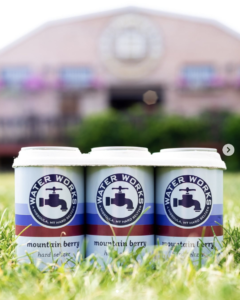 Draught Works also launched a seltzer brand this year, dubbed Water Works – a tribute name to local conservation open lands iconic to the north hills above Missoula. “Seltzer has been a fun challenge for our entire brew team to create something as clean as the national leaders while simultaneously diversifying our products and offerings,” says Jeff Grant, co-founder of Draught Works.
Draught Works also launched a seltzer brand this year, dubbed Water Works – a tribute name to local conservation open lands iconic to the north hills above Missoula. “Seltzer has been a fun challenge for our entire brew team to create something as clean as the national leaders while simultaneously diversifying our products and offerings,” says Jeff Grant, co-founder of Draught Works.
Big Sky Brewery, another Missoula brewery, launched their Spiked Seltzer last year with compelling flavor combinations like ginger lemon basil and a classic Montana flavor, huckleberry. Marketed as “a refreshing take on water” Big Sky’s seltzers are a low-carb and gluten free alternative to their ever-popular beers.
Local craft consumers are looking for a better hard seltzer, and therein lies the competitive advantage for Montana craft breweries. Consumers want local, functional, real food ingredients, in new and exciting flavors. They want a brewer who looks out for their health yet never bores them and is willing to innovate on process and flavor. Thankfully, these are exactly the types of approaches that will enable craft brewers to rise above the din of lifeless malternatives spilling onto the floors of your local convenience and grocery store.
As seltzer grows in popularity, its demographic also grows, and increasingly overlaps with craft drinkers. While there isn’t evidence that seltzer is taking craft volume, there is evidence that many seltzer drinkers care about attributes where craft brewers can be strong players. This gives craft breweries new opportunities to engage with customers previously untouched, especially those who usually drink domestic light beer. Craft breweries have the scale to try new things, experiment with process, use locally sourced seasonal ingredients, and experiment with wild flavor combinations. So next time you’re mulling about the beer aisle, have a look at the fun new hard seltzers from local Montana breweries and give one a try!
The COVID-19 pandemic will certainly be the story of 2020. This historic public health crisis poses the most significant challenge the modern craft brewing industry has ever faced.
When the first cases were being reported in the United States in February, we didn’t fully understand the scale and duration of the effects it would have on the industry. But the picture started to come into focus when in mid-March, local health departments in Gallatin, Lewis & Clark, Missoula, Silver Bow and Yellowstone Counties issued closure orders affecting businesses including breweries. Six months later, it’s clear this was not just a passing blip on the radar.
Fortunately, breweries in Montana were not forced to close entirely, and were able to remain open for to-go beer and delivery through the closure orders and statewide stay-at-home directive. Under the Reopening the Big Sky plan, announced by Gov. Bullock on April 22, breweries would be able to welcome guests back into their taprooms, but with 50 percent capacity and no bar seating under Phase I. The capacity limitations, an important part of the public health response, would make it difficult for many businesses to remain profitable. The MBA requested a simple solution to provide relief – make it easier for bars, restaurants, breweries and other beverage manufacturers to expand their outdoor seating. In response to these concerns, the Department of Revenue issued temporary rules in advance of the May 4 reopening that provide a streamlined approval process for additional outdoor seating.
While early action in Montana helped slow the spread of COVID-19 and allowed breweries to maintain vital sources of revenue, at a time breweries in some states were forced to close entirely, we still saw a significant reduction in business during the spring. A survey of Montana breweries conducted by the MBA in late April and early May found that 75 percent of breweries had laid off staff. The survey also revealed that the pandemic was creating a shift in where and how consumers purchase beer. Onsite sales (sales through taprooms, limited to to-go and delivery orders at that time) were down 46 percent. Distributed draft sales (sales of kegs to bars and restaurants) were down 61 percent. However, distributed package sales were slightly up.
These numbers help illustrate a trend you can witness any day at your local grocery store. Beer drinkers are buying more beer in cans and bottles and are drinking less at bars, restaurants and breweries. It’s a significant shift in the marketplace.
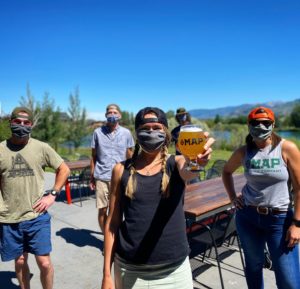
Breweries that are larger, more diversified and already selling beer in package, are better positioned to weather this storm. Meanwhile, smaller, more taproom-focused breweries face greater challenges.
But brewers are innovators and problem solvers. Montana breweries are figuring out how to maintain the atmosphere that beer lovers want in the taproom experience, while creating an environment that is safe for employees and customers alike. In response to the trends in off-premises sales, more breweries are also taking steps to get their beer into package by investing in a canning line or working with a third-party to provide canning equipment and services.
The pandemic is shifting consumer habits and causing disruptions for brewers. The impacts are also being felt by our industry partners, including suppliers such as barley farmers, hops growers and maltsters.
“COVID has thrown a real cloud of uncertainty in the air,” says Jake TeSelle, founder of Crooked Yard Hops. “As a Farmer, I am used to a certain level of risk, but it’s incredibly discouraging to work long, hard days in the field not knowing with certainty that these hops will have a home at harvest time.”
TeSelle hopes the brewing community will stand strong together and through this experience develop a new appreciation and focus on securing and supporting local suppliers.
Since the spring, Montana began the process of reopening and we entered summer tourist season, bringing customers back into taprooms, bars and restaurants and boosting onsite and distributed draft sales. However, the entire hospitality industry is still far below what we would expect in a normal year. Public health requirements mean that bars, dining rooms and taprooms are operating at 75 percent seating capacity, and that may not even be possible for many when six-foot social distancing requirements are factored in.
While summer has been better than the spring for Montana breweries, additional challenges are on the horizon. The boost from summer tourist season will soon come to an end. Expanded outdoor seating has been helpful for breweries and popular with consumers, but will become less viable with the changing seasons. While more breweries move into package, aluminum can shortages, exacerbated by both the pandemic and aluminum tariffs, are causing delays for can orders, adding yet another challenge to the equation.
All indications are the pandemic is far from over, and we expect a challenging winter ahead for breweries and the hospitality industry as a whole. The current situation highlights the importance of supporting local businesses – from breweries purchasing local malt and hops to Montanans choosing local Montana craft beer. Craft breweries and other local businesses need your support now more than ever.
Montana Brewers Association
P.O. Box 8591
Missoula, MT 59807
406-948-BREW (2739)